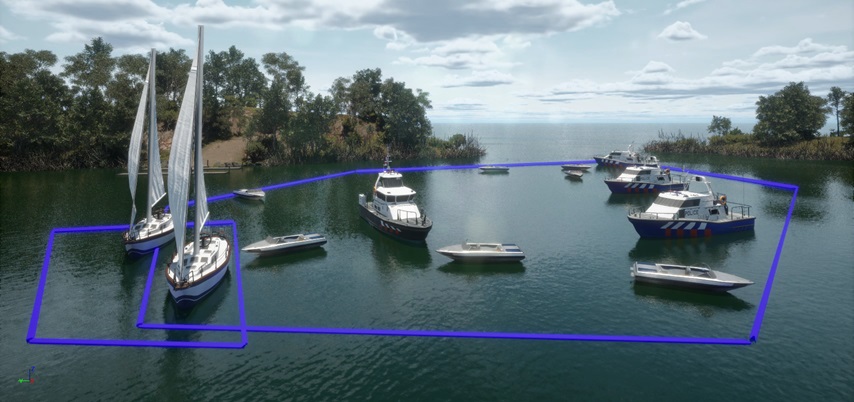Scatter assets randomly¶

Learn how to declare object positions quickly using SpawnZone.
Random scattering of assets within a defined zone. |
SpawnZone provides a quick and easy way to scatter assets randomly within a
specified area, without having to go through the tedious process of manually
handcrafting each object’s position and rotation.
Creating a SpawnZone object can be driven by two types of geometries,
Polygon and Spline. These geometries define the line or area on/in which
the assets will be scattered.
Scatter assets randomly in an area¶
Scattering assets in an area is useful for quickly placing larger amounts of distractors or background objects. Below, we scatter 10 harbor launch boats within a polygon formed from points we pick from the viewport.
Tip
To create Polygons faster, use the
Coordinate Picker
viewport tool to pick coordinates from the viewport, which will copy them to your clipboard.
Pass these coordinates to Vector3 points to create a Polygon.
1from bbi import *
2
3world = World("lake")
4
5# Set the camera to the desired position
6world.camera.set_transform(
7 Transform(
8 position=Vector3(0, 0, 10),
9 rotation=Vector3(0, 3, 175),
10 ),
11)
12
13# Use the picker to select SpawnZone boundary points
14poly = Polygon(
15 node_id="my_poly",
16 points=[
17 Vector3(-47.4, 34.95, 0),
18 Vector3(-19.95, 16.03, 0),
19 Vector3(-21.03, -12.97, 0),
20 Vector3(-70.03, -50.12, 0),
21 Vector3(-115.83, -39.97, 0),
22 Vector3(-85.21, 22.47, 0),
23 ],
24)
25world.add(poly)
26
27zone = SpawnZone(
28 node_id="my_zone",
29 asset_names=[
30 "Ivory MT",
31 "Grimmershorn",
32 "USCG Auxiliary Boat",
33 "CoastGuard Ship Singapore B",
34 "CoastGuard Ship Singapore A"
35 ],
36 quantity=15,
37 geometry=poly,
38 asset_type=Asset, # or BuoyantAsset
39 yaw_range=(0, 360),
40 asset_weights=[1, 1, 1, 1, 1],
41 force_respawn=True,
42)
43world.add(zone)
44
45scenario = world.new_scenario(num_frames=5)
46scenario.preview_animation()
First, we create a Polygon object using the coordinate picker tool.
Next, we create a SpawnZone object and specify the following:
Argument |
Functionality |
|---|---|
|
A unqiue ID for the SpawnZone. |
|
A list of asset names to spawn. Select assets from Bifrost’s asset library by clicking on the Asset tab on the bottom drawer at the top of the notebook. |
|
The maximum number of assets to spawn. The actual number of assets spawned might be less than this number if there isn’t sufficient space in the geometry. |
|
The defined geometry to spawn the assets in. |
|
The type of asset to spawn. Defaults to Either BuoyantAsset or Asset. |
|
The max and min yaw in degrees of the spawned assets. Defaults to For splines, the rotation would be the tangent to the spline at the spawn point. |
|
The relative weight of spawning each asset in the The weights will be normalized to a probability internally. |
|
Forcibly respawn assets in scenarios at each keyframe. Defaults to If the SpawnZone parameters change between frames, assets will be respawned regardless of this value. |
Finally, we add the SpawnZone to the world and create the scenario and the assets will be scattered within the bounds of the specified geometry.
Attention
When two or more SpawnZones overlap, the zone that was added first will
take precedence, spawning its assets first. Subsequent zones will look for
available space to avoid collisions with existing assets.
poly2 = Polygon(
node_id="my_poly_2",
points=[
Vector3(-36.45, 37.98, 0),
Vector3(-41.17, 23.14, 0),
Vector3(-18.62, 9.87, 0),
Vector3(-18.15, 19.91, 0),
],
)
world.add(poly2)
zone2 = SpawnZone(
node_id="my_zone_2",
asset_names=["Irwin 38"],
quantity=10,
geometry=poly2,
)
world.add(zone2) # Added second. Will avoid assets spawned by zone1.

Defining or using existing geometries in the world¶
Using World geometries¶
Some worlds are shipped with prebuilt geometry that can be used to drive SpawnZones.
Access a list of available geometries using:
world.get_cuboids() # returns a list of Cuboid geometries
world.get_splines() # returns a list of Spline geometries
Define your own geometries¶
Alternatively, define your own shapes using Geometry. You can create multiple SpawnZones
using the same geometry, which is useful for spawning specific quantities of assets in the same area.
You can use the following geometries to define your SpawnZones:
A 3D polygon defined by a list of Vector3 points. |
|
A curved spline constructed using a list of Vector3 positions, and optionally a list of Vector3 tangents. |
Note
It is optional to add the geometries to the world. Add them if you want to visualize them with the “Show guide geometry” option at the top left of the viewport.
world.add(area1)
world.add(area2)